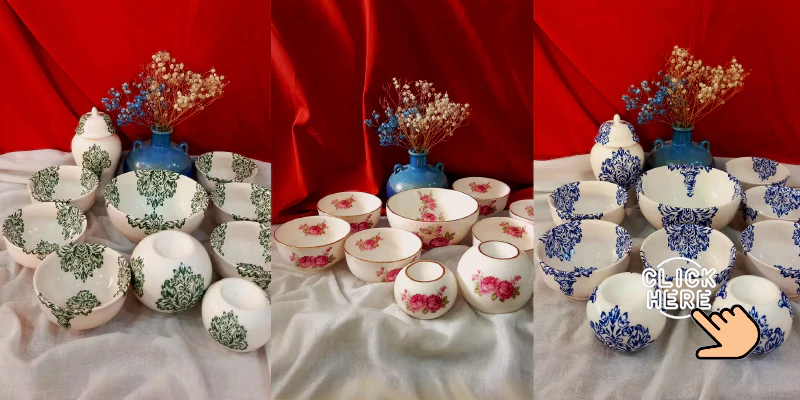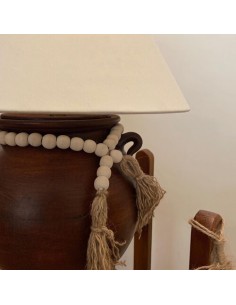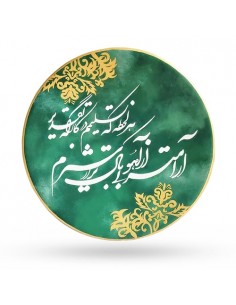- Mahsa S. Y.
- HandiCrafts
- 1110 views
- 2 comments
Whether you want to paint a flower vase to decorate your home's living room or create personalized gifts for your loved ones, pottery painting is one of the best ways to be unique. You can transform raw and simple pottery into a stunning masterpiece with suitable materials, techniques, and creativity.
Moreover, you may be looking for a place to do pottery art as a hobby for one day or want to have your kids engaged and amused with painting art training. So, stay with this article to become a pottery painting artist as quickly as pie.

The Process of Painting Pottery
Like every other technique, pottery painting includes stages and steps. Here, you study the step-by-step process of painting pottery, which provides for a training of selection or creation, drawing, painting, and baking, depending on whether the pottery is glazed or not.
Create or Pick a Pottery Item
The first step in the pottery painting process is to select the piece of pottery you want to paint. You can choose from various items, including terra cotta pots, ceramic mugs, plates, bowls, flower vases, and other home decor items. Many pottery studios offer a wide selection of pre-made pieces for painting, or you can create your piece from scratch if you have access to a pottery wheel or mold.
Glazed Pottery Painting
If you're painting glazed pottery, clean the surface with a microfiber cloth to remove dust or debris before applying paint. It will ensure proper paint adhesion to the glazed surface.

First, Apply a Primer
applying a primer coat to the pottery surface is a good idea before you start painting. Primer helps the paint adhere better and provides a smooth base for your design. Select a primer for pottery surfaces and apply it evenly with a brush or sponge.
Cyrus Crafts; Luxury & Unique Products
Draw or Plan for a Design
Once the primer is dry, you can begin planning your design. Whether you're painting freehand or using a stencil, sketching out your design beforehand is helpful to ensure that you achieve the desired result. You can also use tracing techniques or stencils to transfer intricate designs onto the pottery surface. You can draw it with Minakari painting techniques. If you want to know it, read about and visit Minakari products by clicking on the picture below.
Dye your Pottery Painting Design
Now, choose your paints carefully, considering the type of finish you want to achieve and whether you prefer traditional ceramic paints or more modern acrylics. Ceramic painting pens can be handy for intricate designs, while pastel porcelain paints are perfect for achieving soft, delicate colors.
Unglazed Pottery Painting
If you're painting unglazed pottery, you'll have more flexibility in the type of paint you can use. Acrylic paint sets are a popular choice for unglazed pottery, as they are durable, easy to work with, and come in a wide range of colors. You can also experiment with different painting techniques, such as marbling or layering, to create unique effects.

Seal the Plans
Once you've finished painting your pottery, it's essential to seal the design to protect it and ensure its longevity. You can use a variety of sealants for this purpose, including shellac, varnish, or clear glaze. Apply the sealant evenly over the entire pottery surface and allow it to dry completely before proceeding to the next step. It makes your unique handicraft a long-lasting one.
Bake, Glaze, and Bake Again
If you're working with ceramic paints, you must bake the pottery in a kiln to set the paint and create a durable, long-lasting finished pottery. Follow the manufacturer's instructions for baking times and temperatures, and allow the pottery to cool completely before handling it. Once the pottery has been baked, you can reglaze and bake it again to achieve a glossy finishing.
Which Paints Can You Use on Pottery?
When choosing paints for pottery, selecting ones specifically formulated for use on ceramic surfaces is essential. Acrylic paints are versatile options for both glazed and unglazed pottery, while porcelain paints are ideal for achieving a glossy, professional finish. Ceramic paint pens, enamel paints, latex paints, and spray paints are other convenient options for detailed work, allowing for precise application without brushes.

Choose the Right Paint for Pottery Pieces
The type of paint you pick depends on the surface you want to paint and the effect you want to achieve. If you're painting glazed pottery, it's best to use paints that adhere well to slick surfaces and provide good coverage.
On the other hand, if you're painting unglazed pottery, you should go for durable paints compatible with the clay's porous surface. Or if it is a pot painting, you will need water-resistant coatings.
The Best Paint for Pottery Painting
When it comes to the best paints for pottery painting, it ultimately comes down to personal preference and the specific requirements of your project. However, most artisans believe that acrylic paints are the best.
You can experiment with different paints and brands to find ones that suit your style and budget. Remember to consider factors such as color selection, durability, and ease of use when making your decision. CyrusCrafts artist use colors with the highest qualities when creating an artwork. For example, you can see our decorative bowls by a click on the following image.
Pottery Painting Studios, Places for Doing Social Art
Pottery painting studios are places for people of all ages to gather and engage in social art activities. Whether you're looking for a fun outing with friends, a unique date night idea, or a creative activity for kids, training pottery painting studios offer a welcoming and supportive environment for artists of all skill levels to paint your own pottery.
Many studios also offer pottery classes and workshops, where you can learn new techniques and hone your skills under the guidance of experienced instructors to DIY a neat art. Lalejin, in Hamadan, Iran, the world's pottery town, has numerous studios that make you a joyful day doing this art 0 to 100 by your own.
Here is what you need to know about pottery studio and clay café.
FAQs of Pottery Painting
Here, you go with the most frequently asked questions about pottery painting and brief answers for each one:
1. Are Pottery Paints Washable?
Pottery paints are typically not washable after they are adequately cured or baked according to the manufacturer's instructions. Yet fortunately, once the paint has set, the pottery item can be gently hand-washed with mild soap and water without damaging the painted surface.
2. Is Pottery Paint Dishwasher Safe or Waterproof?
Pottery paint may not always be dishwasher-safe or fully waterproof, especially if it hasn't been properly sealed or glazed. Nevertheless, most ceramic paints are designed to withstand dishwasher cycles and moisture, but it's essential to check the specific product instructions to ensure durability and water resistance.
3. Is It Possible to Paint Pottery with Watercolor or Ordinary Paints?
It's not recommended to paint pottery with watercolor or ordinary paints meant for wall, paper, or canvas. Pottery surfaces require specialized paints formulated to adhere to ceramic surfaces and withstand high temperatures during the firing process.
Watercolor and ordinary paints are unsuitable for pottery painting as they may not adhere properly and could wash off or smudge.
4. How Many Coating Layers of Paint Are Needed for Pottery Painting?
The number of coating layers needed for painting potteries depends on the desired effect and the paint used. Typically, at least two or three coats of paint are applied to achieve full coverage and vibrant colors.
However, detailed designs or specific effects may require additional layers. Allowing each layer to dry completely before applying the next to prevent smudging or blending is essential.
5. Can You Eat Food in Painted Pottery Dishes?
Whether you can eat food in painted pottery dishes depends on the type of paint used and whether the item has been properly sealed and glazed. If the pottery has been painted with food-safe, non-toxic paints and sealed with a food-safe glaze, it should be safe for serving food.
Nonetheless, it's essential to verify the safety of the paint and glaze used and to follow any specific care instructions provided by the manufacturer. All paints used in CyrusCrafts pottery tableware items are non-toxic and food safe. So, you can serve hot foods and beverages in them. For instance, surf our tea sets page by clicking on the below picture.
The Final Statements of CyrusCrafts about Pottery Painting
In this blog post, you studied every detail about pottery painting, including the needed equipment, step-by-step process, studios offering one-day pottery training, and frequently asked questions about pottery paints. If you have any other questions or ideas about this subject, please write them in the comments section. We will answer them at the double.
CyrusCrafts, the international handicrafts' resource, offers selections of pottery art by professional artists at the best prices, without dealers. In other words, we retail all our products directly from the artisan's spot to your houses. A click on the following picture leads you towards a collection of handmade pottery tableware and ceramic items.
If you want to order a product, fill out their order form. If you have any inquiries about the ordering process, like delivery or wholesale prices, ask them by clicking the WhatsApp icon.
CyrusCrafts retails and wholesales Persian rugs, handicrafts, handmade furniture, home decor items, garments, style accessories, and Iranian food products such as pistachio, saffron, caviar, etc., to the world by shipping and cargo, which is more inexpensive for the Middle East, USA, and Canada residents.























Comments (2)